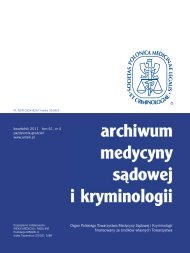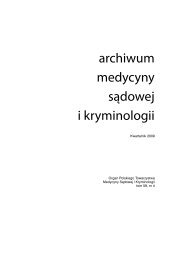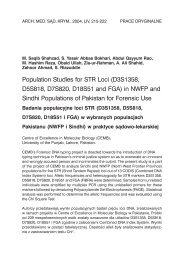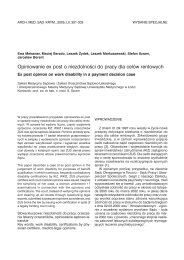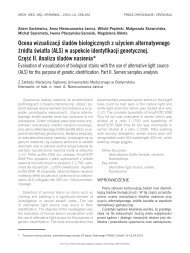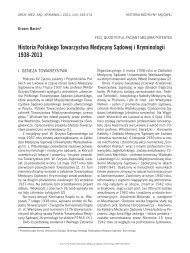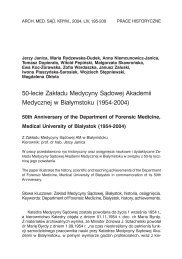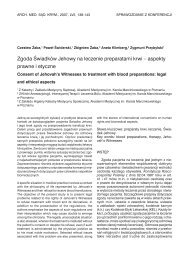PeÅny numer do pobrania (*.pdf) - Archiwum Medycyny SÄ dowej i ...
PeÅny numer do pobrania (*.pdf) - Archiwum Medycyny SÄ dowej i ...
PeÅny numer do pobrania (*.pdf) - Archiwum Medycyny SÄ dowej i ...
You also want an ePaper? Increase the reach of your titles
YUMPU automatically turns print PDFs into web optimized ePapers that Google loves.
ARCH. MED. SĄD. KRYMINOL., 2012, LXII, 178-185<br />
PRACE ORYGINALNE / ORIGINAL PAPERS<br />
Marek Wiergowski<br />
Propozycja interpretacji wyników analitycznych uzyskanych<br />
w pobliżu prawnej granicy stężeń dla stanu po użyciu alkoholu<br />
lub stanu nietrzeźwości<br />
Proposal of interpreting analytical results indicating borderline-legal alcohol<br />
concentration values in individuals after alcohol consumption or being<br />
alcohol-intoxicated<br />
Z Katedry i Zakładu <strong>Medycyny</strong> Są<strong>do</strong>wej Gdańskiego Uniwersytetu Medycznego<br />
Kierownik: dr hab. med. Z. Jankowski<br />
Interpretacja wyników analitycznych uzyskanych<br />
w pobliżu prawnej granicy stężeń dla stanu<br />
po użyciu alkoholu lub stanu nietrzeźwości wymaga<br />
uwzględnienia wielu czynników, takich jak: bezpieczeństwo<br />
ruchu drogowego, niepewność pomiarową<br />
oznaczenia etanolu w powietrzu wydychanym,<br />
procesy metaboliczne alkoholu w organizmie, możliwość<br />
wystąpienia alkoholu zalegającego w jamie<br />
ustnej. Zarządzenie nr 738 Komendanta Głównego<br />
Policji z dnia 21 czerwca 2011 roku wprowadza<br />
obowiązek weryfikacji wyników w pobliżu granicy<br />
stężenia 0,1 mg/l poprzez wykonanie trzeciego<br />
pomiaru, jednak interpretacja tych wyników jest<br />
dyskusyjna. W pracy zaproponowano nowy sposób<br />
przeprowadzenia pomiarów i ich interpretacji.<br />
Interpretation of analytical results indicating borderline-legal<br />
alcohol concentration values after the substance<br />
intake or intoxication requires consideration<br />
of many factors, such as: road safety, measurement<br />
uncertainty, determination of ethanol in breath, alcohol<br />
metabolism in the body, the possibility of residual<br />
alcohol in the mouth. Decree No 738 of the Chief<br />
of Police issued on 21 June 2011, introduces the<br />
obligation to verify the results ranging close to the<br />
borderline concentration of 0.1 mg/l by executing the<br />
third measurement, but the interpretation of these<br />
results is questionable. The paper proposes a new manner<br />
of taking measurements and their interpretation.<br />
Upon arriving at the scene the police should record<br />
the starting time of testing the driver and wait 15<br />
minutes (the time required to eliminate residual<br />
alcohol). If, after that time, the first result falls within<br />
the borderline values legally described as the condition<br />
after alcohol consumption or alcohol intoxication,<br />
the second and third measurements should<br />
be taken immediately. Thus, three measurements<br />
taken quickly in a few minutes should not be affected<br />
by the alcohol metabolism in the body. If two of the<br />
three determined values are less than or equal to<br />
0.09 mg/l, the driver should be pronounced sober.<br />
If two of the three results are within the range of<br />
0.10-0.25 mg/l, the result indicates condition after<br />
alcohol intake. If two of the three results are equal<br />
to or more than 0.26 mg/l, the status of the driver<br />
may be described as alcohol intoxication.<br />
Słowa kluczowe:<br />
interpretacja stężenia etanolu w powietrzu<br />
wydychanym i we krwi,<br />
prawna granica stanu po użyciu alkoholu<br />
i stan nietrzeźwości<br />
Key words:<br />
interpretation of ethanol concentration<br />
in breath and blood,<br />
borderline-legal alcohol concentration<br />
values and state of alcohol intoxication<br />
WSTĘP<br />
Problematyka określania stanu trzeźwości kierowcy,<br />
u którego oznaczono stężenie alkoholu w powietrzu<br />
wydychanym lub we krwi na granicy okre-<br />
2012 © by Polskie Towarzystwo <strong>Medycyny</strong> Są<strong>do</strong>wej i Kryminologii, ISSN 0324-8267



